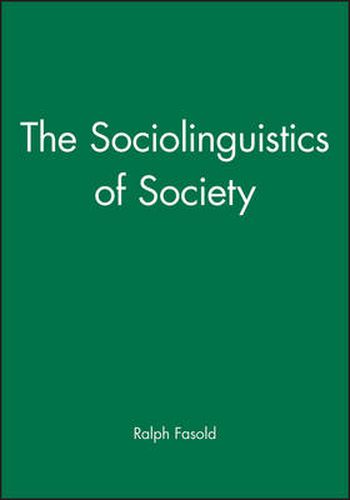Readings Newsletter
Become a Readings Member to make your shopping experience even easier.
Sign in or sign up for free!
You’re not far away from qualifying for FREE standard shipping within Australia
You’ve qualified for FREE standard shipping within Australia
The cart is loading…






This is an introduction to those aspects of sociolinguistics broadly described as the sociology of language; the effect of language and dialect differences on society.Beginning with a general description of the social consequences of several languages being used in one society, Ralph Fasold moves on to discuss ‘diglossia’, the phenomena by which social functions are assigned to languages and dialects in a predictable manner. Other aspects of the subject covered here include social attitudes towards various languages and dialects, the social forces which influence multilingual people to use different language sin different situations, and wholesale shifts by social groups from one language to another (and the converse, retention of particular languages. The theory and practice of language planning, and the significance of language in education, are examined and explained. In addition, the book deals with qualitative and quantitative methods of analysing multilingualism and includes a helpful chapter on statistical techniques.Written by a leading sociolinguist and teacher, this textbook is a comprehensive and authoritative guide to the field. With the beginner in mind, the author writes in a clear, relaxed style, explaining current theories and giving many examples from all parts of the world. The second volume of this book, The Sociolinguistics of Language make up the definitive introductory account of the subject for students throughout the world.
$9.00 standard shipping within Australia
FREE standard shipping within Australia for orders over $100.00
Express & International shipping calculated at checkout
This is an introduction to those aspects of sociolinguistics broadly described as the sociology of language; the effect of language and dialect differences on society.Beginning with a general description of the social consequences of several languages being used in one society, Ralph Fasold moves on to discuss ‘diglossia’, the phenomena by which social functions are assigned to languages and dialects in a predictable manner. Other aspects of the subject covered here include social attitudes towards various languages and dialects, the social forces which influence multilingual people to use different language sin different situations, and wholesale shifts by social groups from one language to another (and the converse, retention of particular languages. The theory and practice of language planning, and the significance of language in education, are examined and explained. In addition, the book deals with qualitative and quantitative methods of analysing multilingualism and includes a helpful chapter on statistical techniques.Written by a leading sociolinguist and teacher, this textbook is a comprehensive and authoritative guide to the field. With the beginner in mind, the author writes in a clear, relaxed style, explaining current theories and giving many examples from all parts of the world. The second volume of this book, The Sociolinguistics of Language make up the definitive introductory account of the subject for students throughout the world.